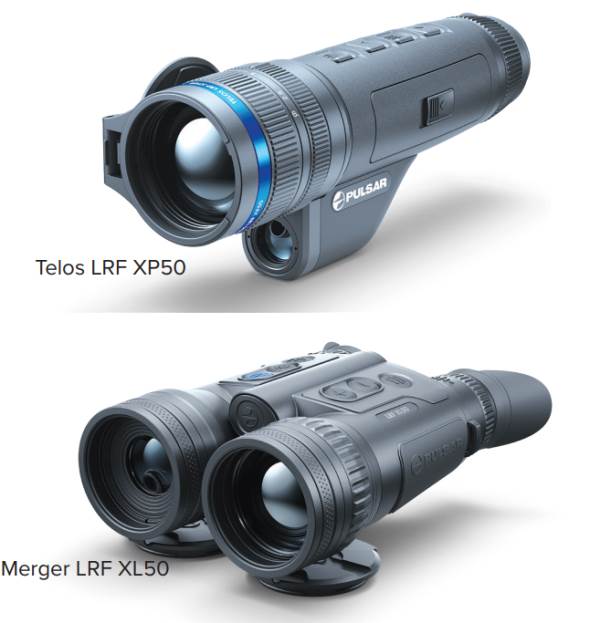
My thoughts on Pulsar’s new Telos LRF XP50 and Merger LRF XL50
I’ve used the new Pulsar Telos LRF XP50 for a couple of months now and the Pulsar Merger LRF XL50 for a while longer. Both products represent flagships in Pulsar’s thermal imaging product range, the Telos is their best monocular, and the Merger XL50 is their best bi-ocular.
Both products deliver outstanding results, though offer quite different viewing experiences. The main difference is that the Telos is viewed with one eye and the Merger with two. While this seems like an obvious comparison, the user experience is profoundly different.
Pulsar Telos LRF XP50
The Pulsar Telos thermal monocular replaces the highly popular and now discontinued Pulsar Helion XP50 Pro. Launched in 2017, the Pulsar Helion became an immediate success, with subsequent models each outdoing their predecessors, culminating finally with the Helion XP50 Pro. The Helion Pro model is a hard act to follow and an obvious benchmark for comparison with the Telos.
In terms of features, the Telos has some very distinct advantages over the Helion and other thermal imagers generally. I list them as follows:
• The Telos is available with a laser rangefinder, a feature unavailable with the Helion.
• The Telos has a zoom ring on the lens barrel that is easy to zoom in and out. Initially, I confused the zoom ring with the focus ring, however, with practice this ceased to be a problem.
• The Telos is easy to swap from left-hand to right-hand use. I never found this a problem, but for left-handed users this would be a distinct advantage.
• The Telos is factory hardware upgradeable, though no upgrades are yet available.
• The Telos battery can be charged with a wireless cell phone charger and also has a USB-C charging port. These features are brilliant!
The Telos XP50 also has NETD sensitivity of less than 18mK, which is substantially better than the Helion XP50 Pro and all other uncooled thermal imagers. The detail rendered in the image is extremely good as is its performance in rain.
Another very interesting development is the use of a cast Polymeric housing. Though it is essentially a plastic, Polymeric materials have nanotubes that efficiently conduct heat and are less costly to manufacture than magnesium allow housings. Polymeric polymers are cutting edge technology, kudos to Pulsar for seizing on this new development.
I do have a couple of gripes about the Telos. I’m a little disappointed that the objective lenses cannot be interchanged like with the Helion XP series. And secondly, the record button is now situated towards the front of the button panel. I like to record often, and I miss the ease of pressing the rear-most button to start and stop recording.
The Pulsar Telos LRF XP50 is a very fine successor to the Helion XP50 Pro. Both models have a 50mm f1.0 lens, 640×480 Lynred sensor and AMOLED HD display. The Telos has a higher sensitivity, which may be a combination of improvements, such as the polymeric housing, improved image processing etc.
The Pulsar Telos LRF XP50 retails for $7499 which is remarkably good considering it has a laser rangefinder and only costs $200 more than the Helion XP50 Pro.
Pulsar Merger LRF XP50
In a nutshell, I would marry this thermal and have its babies if I could! It is simply the best thermal viewing experience ever.
At $11,999 it certainly isn’t cheap, but neither is a Ferrari. The image quality is spectacular due to its whopping 1024×768 Lynred sensor, 50mm f1.0 lens, AMOLED HD display and its two eyepieces. Looking through it feels natural and the image looks really big compared to a monocular.
The field-of-view is very impressive for a 50mm objective lens, but its zoom magnification is its real strength. These are my findings:
• At base magnification of 2.5x, the image detail is breathtaking because the sensor and display have the same HD 1024×768 resolution, meaning no interpolation is required (artificially generated pixels) to fill-up the display area.
• At 2x zoom, the magnification is 5x and the detail is almost as fine as a 640×480 thermal at base magnification. Very impressive.
• At 3x zoom, the magnification is 10x and still very good, with enough detail to render differences in distant objects.
• At 4x zoom, the magnification is 20x. I don’t find this particularly useful because it is difficult to hold the device steady and the image is quite pixelated, though not as much as smaller sensors with a x4 zoom.
Because the Merger’s magnification can be finely adjusted throughout its zoom range, I will experiment with higher magnifications and write about this in a future article.
It is hard to pick fault with the Merger, however, I would like to be able to remove 4x zoom from its quick zoom button. Like its popular stablemate the Merger LRF XP50, the XL model is very comfortable, easy to use and is used by Coastguard New Zealand and Police.
The Pulsar Merger LRF XL50 has become my go-to thermal imager. It will take something spectacular to knock it off its perch. Watch this space!













